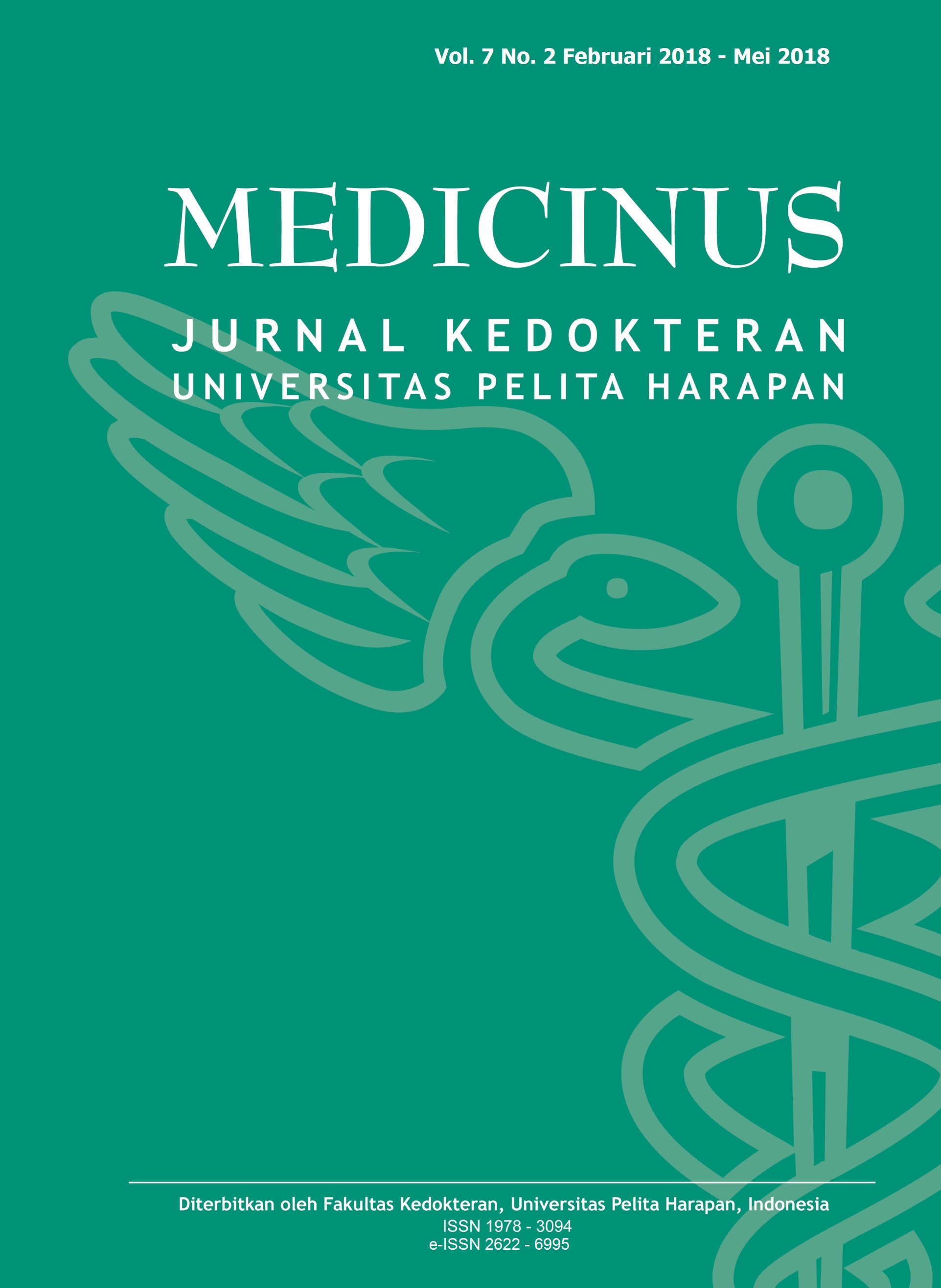Pseudokista Pankreas pada Pasien Pediatrik yang Diterapi dengan Drainase Eksternal
DOI:
https://doi.org/10.19166/med.v7i2.1839Keywords:
Pseudocyst, Pediatric, DrainageAbstract
Background : Pseudocyst of pancreas in pediatric patient is a rare case. Therapy usually conservative, while we wait the wall of the pseudocyst become thick and mature, then followed by internal drainage of jejunum and the pseudocyst. The controversy arise in this case where the external drainage is performed due to feeding trouble with significant decrease of the patient’s body weight after trauma. The purpose of this case report is to give insight that external drainage is possible and should be considered in pediatric patient with pseudocyst of pancreas, primarily where the exploratory by laparoscopy is possible and feeding problem becomes the main problem.
Case : A 4 year old boy come to ER with chief complain pain at the gastric region after blunt abdominal trauma 12 hours before admission. Primary survey was normal with stabile hemodynamic. At first admission, the physician found abdominal distention with tenderness and rebound tenderness without muscular rigidity. In bed-site abdominal USG free fluid was found without abnormality at the solid nor hollow organs. Abdominal CT showed no active bleeding nor abnormality. After 1 week of inpatient care, feeding (even fluid by oral feeding)becomes a constant problem and abdominal distention is increasing.
Therapy : Exploratory by laparoscopic of the abdomen cannot be conducted due to inadequate instruments, then exploratory laparotomy was chosen. Pseudocyst of pancreas was found, 5x4 cm in size with hematoma at the tail of pancreas. External drainage was performed. After the operation the patient dramatically improved, he could tolerate both fluid and solid diet. The patient discharged 4 days after the operation. 3 months after the 1st operation, the patient come with good condition and minimal fluid come from the drain, so the drain was pulled out. Internal drainage was not needed in this case.
Conclusion : External drainage could be considered in pediatric patient with pseudocyst of the pancreas if the feeding problem becomes prominent and the laparoscopic instrument is available.
References
1. D R Cooney and J L Crosfeld. Operative management of pancreatic pseudocysts in infants and children: a review of 75 cases. Ann Surg. 1975 Nov; 182(5): 590-596
2. O S Chaurasiya and S Gupta Pancreatic pseudocyst in a child: A case report. Curr Pediatr Res 2015; 19 (1 & 2): 55-57
3. Ahearne, Paul M. Pancreatic Pseudocysts. In: Sabiston Jr., David C; Lyerly, H Kim. Sabiston Essentials of Surgery (2nd Edition, 419-422). Philadelphia, PA: W.B. Saunders Company.
4. Herman, Richard; Guire, Ken E; Burd, Randall S; Mooney, David P; Ehlrich, Peter F. Utility of amylase and lipase as predictors of grade of injury or outcomes in pediatric patients with pancreatic trauma. Journal of Pediatric Surgery 2011;46:923-926.
5. Nijs, Els; Callahan, Michael J; Taylor, George A. Disorders of the pediatric pancreas: imaging features. Pediatric Radiology 2005;35:358-373.
6. Ros, PR; Hamrick-Turner, JE; Chiechi, MV; Ros, LH; Gallego, P; Burton, SS. Cystic Masses of the Pancreas. Radiographics 1992;12:673-686.
7. Society Of Gastrointestinal and Endoscopic Surgeons. Minimally Invasive Approach to Pediatric Pancreatic Pseudocysts[Internet] Walsh, Danielle.Los Angeles : SAGES; 2017 [cited 2017 Dec 30] https://www.sages.org/wiki/minimally-invasive-approach-to-pediatric-pancreatic-pseudocysts
8. de Blaauw, I; Winkelhorst, JT; Rieu, PN; van der Staak, FH; Wijnen, MH; Severijnen, RSVM; van Vugt, AB; Wijnen, RMH. Pancreatic injury in children: good outcome of nonoperative treatment. Journal of Pediatric Surgery 2008;43:1640-1643.
9. Paul, Michael D; Mooney, David P. The management of pancreatic injuries in children: operate or observe. Journal of Pediatric Surgery2011;46:1140-1143.
10. Windle, R; Finlay, D; Neoptolemos, JP. Needle aspiration in the treatment of pancreatic pseudocyst in childhood. Annals of the Royal College of Surgeons of England 1983;65:331.
11. Saad, Daniel F; Gow, Kenneth W; Cabbabe, Samer; Heiss, Kurt F; Wulkan, Mark L. Laparoscopic cystogastrostomy for the treatment of pancreatic pseudocysts in children. Journal of Pediatric Surgery 2005;40:E13-E17.
12. Seitz, Guido; Warmann, Steven W; Kirschner, Hans-Joachim; Haber, Hans P; Schaefer, Juergen W; Fuchs, Joerg. Laparoscopic cystojejunostomy as a treatment option for pancreatic pseudocysts in children - a care report. Journal of Pediatric Surgery 2006;41:E33-E35.
13. Yoder, Suzanne M; Rothenberg, Steven; Tsao, Kuojen; Wulkan, Mark L; Ponsky, Todd A; St. Peter, Shawn D; Ostlie, Daniel J; Kane, Timothy D. Laparoscopic Treatment of Pancreatic Pseudocysts in Children. Journal of Laparoendoscopic and Advanced Surgical Techniques. 2009;19(Supplement1):S37-S40.
14. Makris, Konstantinos I; St. Peter, Shawn D; Tsao, Kuo-Jen; Ostile, Daniel J. Laparoscopic Intragastric Stapled Cystgastrostomy of pancreatic Pseudocyst in a Child. Journal of Laparoendoscopic and Advanced Surgical Techniques 2008;18(5):771-773.
15. Kimble, Roy M; Cohen, Ralph; Williams, Stephen. Successful Endoscopic Drainage of a Posttraumatic Pancreatic Pseudocyst in a Child. Journal of Pediatric Surgery 1999;34(10):1518-1520.
Published
How to Cite
Issue
Section
License
Copyright (c) 2019 Freda S Halim

This work is licensed under a Creative Commons Attribution-ShareAlike 4.0 International License.
Authors who publish with this journal agree to the following terms:
1) Authors retain copyright and grant the journal right of first publication with the work simultaneously licensed under a Creative Commons Attribution License (CC-BY-SA 4.0) that allows others to share the work with an acknowledgement of the work's authorship and initial publication in this journal.
2) Authors are able to enter into separate, additional contractual arrangements for the non-exclusive distribution of the journal's published version of the work (e.g., post it to an institutional repository or publish it in a book), with an acknowledgement of its initial publication in this journal.
3) Authors are permitted and encouraged to post their work online (e.g., in institutional repositories or on their website). The final published PDF should be used and bibliographic details that credit the publication in this journal should be included.





